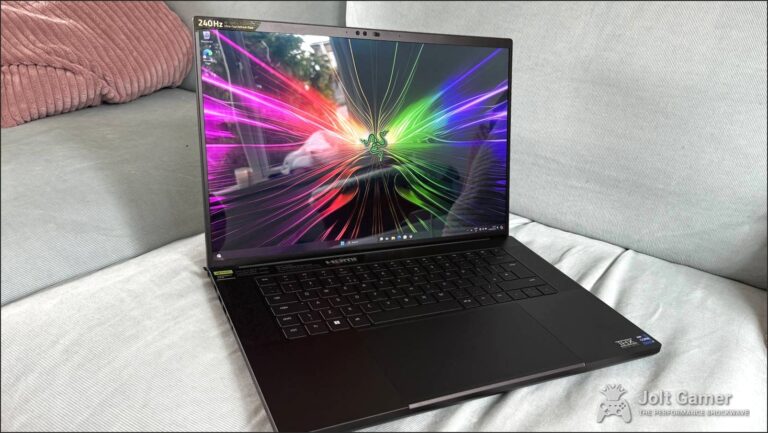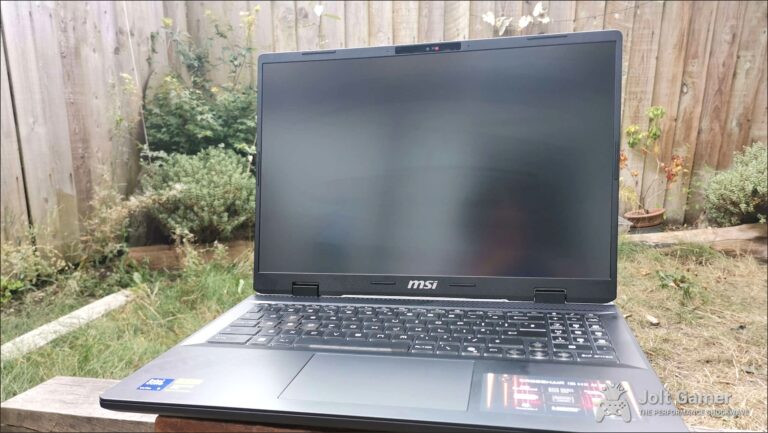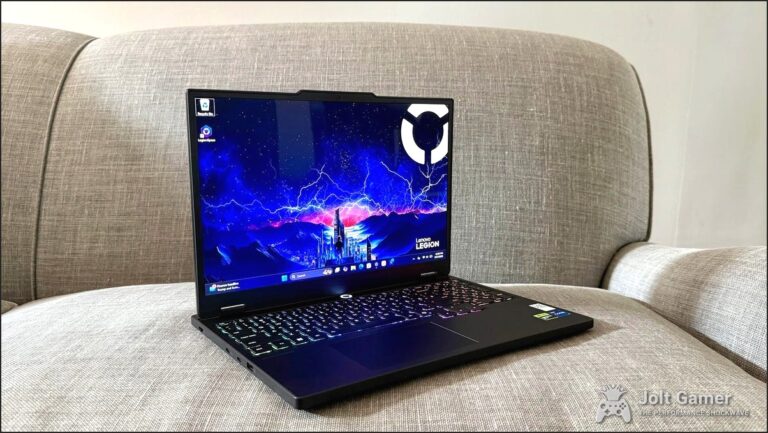The Modular Revolution: Framework Laptop 16’s Journey to Gaming Dominance
Framework has always been a disruptor, challenging the entrenched norms of an industry rife with planned obsolescence. Their vision for consumer electronics is simple yet radical: products designed for longevity, upgradeability, and repair. With the Framework Laptop 16, this philosophy takes on the demanding world of gaming. Traditional gaming laptops are often seen as disposable powerhouses, quickly outdated and impossible to repair. The Laptop 16, especially with its transformative 2025 upgrades, stands in stark contrast. It’s not just a gaming machine; it’s a statement, offering a unique position as a device built to evolve with you, defying the throwaway culture that dominates its competitors.
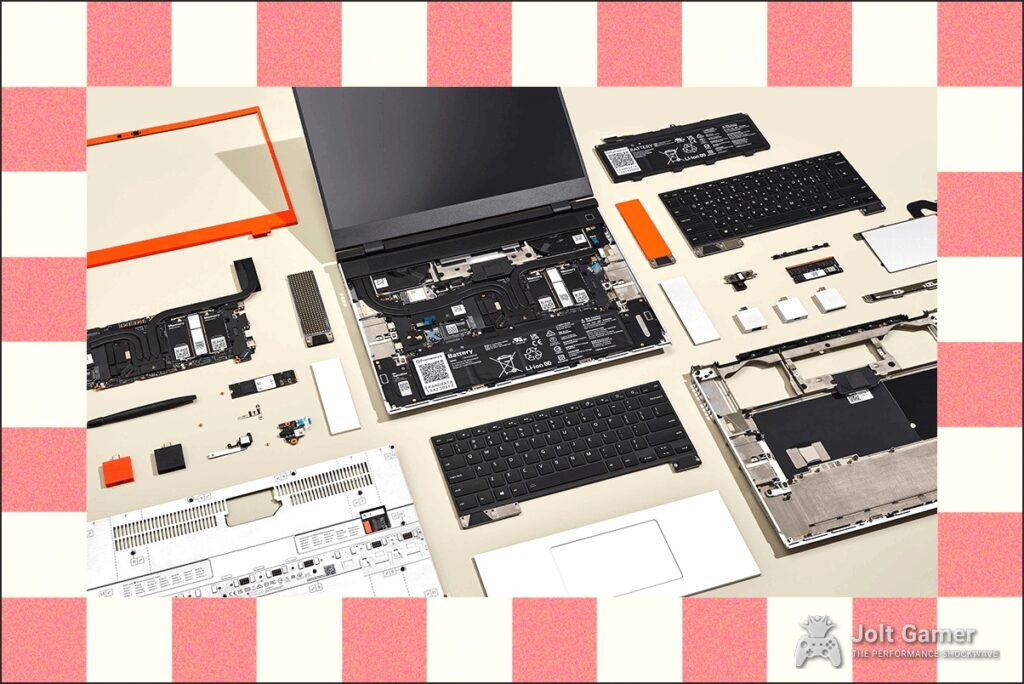
Key Takeaways
- Framework Laptop 16 receives a significant performance boost with new RTX 5070 GPU and Ryzen AI 300 CPUs.
- Modularity and repairability remain core tenets, offering unparalleled longevity and customization.
- Initial build quality and thermal challenges are being actively addressed, but trade-offs exist.
- Competitively priced for its unique value, but still faces challenges against traditional gaming powerhouses.
- This guide serves as a cornerstone resource for understanding the future of upgradeable gaming laptops.
The Right to Repair: Framework’s Unwavering Commitment
Framework’s journey began with a clear mission: to fundamentally change consumer electronics. CEO Nirav Patel, whose work on the One Laptop Per Child (OLPC) project deeply influenced his vision for sustainable computing, founded Framework to champion the “right-to-repair” movement. The Laptop 13 successfully established this paradigm, proving that high-performance, repairable devices were not just possible, but highly desired. With the Laptop 16, Framework has tackled what many considered the “holy grail” of modular computing: a truly upgradeable discrete GPU. This commitment to user empowerment sets it worlds apart from competitors. While ambitious projects like Google’s Project Ara ultimately failed due to compromises in design and durability, and traditional gaming powerhouses like Alienware continue to churn out sealed, proprietary systems, Framework has delivered on its promise. Their Expansion Bay system, allowing for hot-swappable graphics modules, is a testament to this unwavering dedication, offering a path to longevity that others simply cannot match.
“I love my framework 14. I’m far from a power user but as a diesel farm mechanic I really love a company prioritizing repair.”
JoltGamer Community Comment (Fandom Pulse)
- CPU & Mainboard: Easily swapped for future generations (e.g., Ryzen AI 300 series).
- RAM & Storage: Standard, user-accessible DDR5 (up to 96GB) and NVMe SSD slots (up to 10TB storage).
- Expansion Cards: Hot-swappable ports for USB-C, USB-A, HDMI, DisplayPort, Ethernet, MicroSD, and more.
- Input Modules: Customizable keyboard, numpad, macropads, and spacers, controlled by open-source VIA software.
- Discrete GPU: The revolutionary Expansion Bay system for upgradeable graphics, a feat other companies struggled with.
Next-Gen Power: RTX 5070 and AMD Ryzen AI 300 Series Arrive
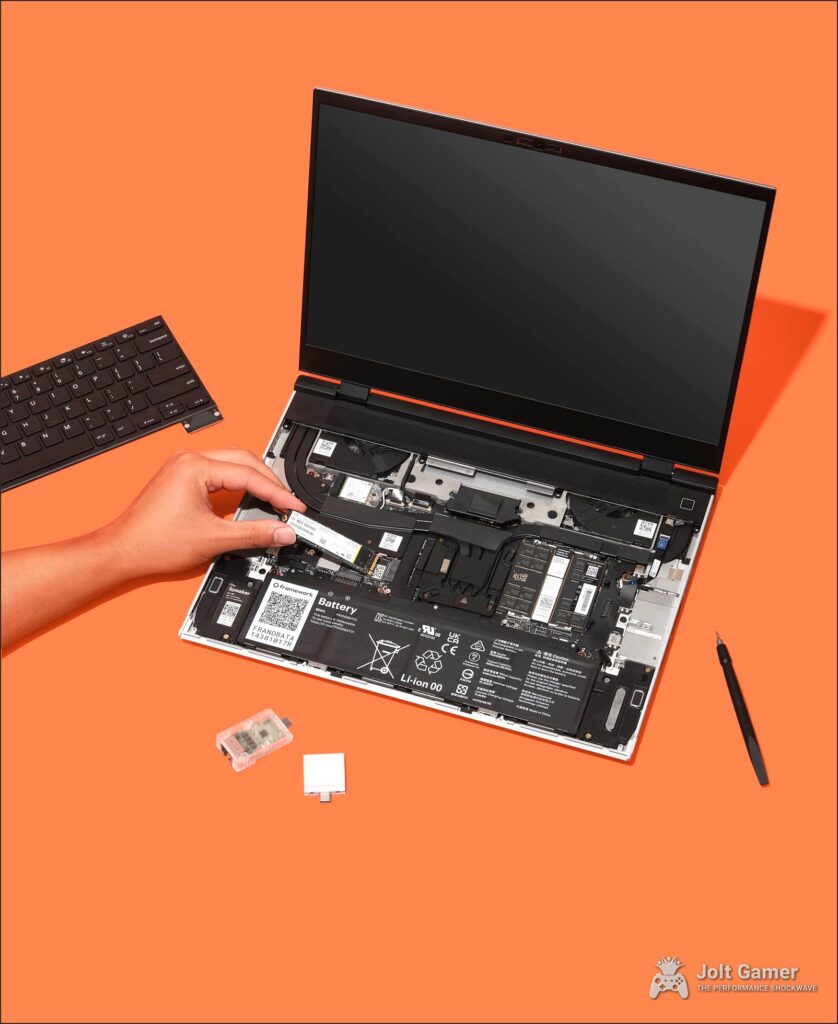
The Framework Laptop 16 is receiving its first major hardware refresh, a pivotal moment for the platform. Headlining this update is the introduction of the powerful Nvidia GeForce RTX 5070 laptop GPU module, poised to dramatically elevate gaming performance. Complementing this, Framework is integrating AMD’s cutting-edge Ryzen AI 300 series chips, specifically the Ryzen AI 7 350 and Ryzen AI 9 HX 370. These new processors bring not only significant CPU enhancements but also dedicated neural processing units (NPUs) for advanced AI workloads, making the Laptop 16 a formidable machine for both gaming and creative tasks that leverage AI. Crucially, Framework remains true to its core philosophy: these new upgrades are fully backward compatible. Owners of existing Laptop 16 models can acquire the RTX 5070 graphics module and the new Ryzen AI 300 series mainboards, seamlessly integrating them into their current systems and reinforcing the device’s unparalleled longevity.
Framework Laptop 16 (2025) Key Upgrades
| New GPU Option | Nvidia GeForce RTX 5070 Laptop GPU (projected 30-40% increase over RX 7700S) |
| New CPU Options | AMD Ryzen AI 7 350, AMD Ryzen AI 9 HX 370 (Zen 5 with enhanced AI capabilities) |
| Power Adapter | Default 240W USB-C PD 3.1 charger (upgraded from 180W) |
| Display | 16-inch WQXGA (2560 x 1600) 165Hz with Nvidia G-Sync, 9ms response time |
| Thermal System | Revamped heatsink, reoptimized fan blade geometry and controller IC, Honeywell phase change thermal interface material |
| Top Cover | Reinforced CNC aluminum top cover |
Key Upgrade Highlight
The new RTX 5070 module is projected to deliver a significant 30-40% performance increase over the original Radeon RX 7700S, making the Framework Laptop 16 a much more potent gaming machine and addressing a core performance desire.
Gaming Benchmarks: From RX 7700S to RTX 5070
For a gaming machine, performance is paramount. The original Framework Laptop 16, equipped with the AMD Radeon RX 7700S, offered respectable gaming capabilities, generally performing on par with an Nvidia RTX 4060 mobile GPU. It delivered solid frame rates in many titles, achieving 74 FPS in Cyberpunk 2077 and 95 FPS in Assassin’s Creed Valhalla at 1080p Ultra settings. While it could push 60+ FPS in older titles at its native 2560×1600 resolution, more demanding modern games often necessitated a drop to 1080p. The arrival of the Nvidia RTX 5070 module, however, is a game-changer. Framework projects a significant 30-40% performance uplift over the RX 7700S, propelling the Laptop 16 into what can be described as “PlayStation 5-class” gaming territory. This substantial boost means smoother experiences at higher resolutions and settings, firmly establishing the Framework 16 as a more serious contender in the competitive gaming laptop market.
Beyond raw horsepower, the overall gaming experience hinges on critical components like the display and thermal management. The Framework Laptop 16 features a stunning 16-inch WQXGA (2560×1600) IPS display, boasting a fluid 165Hz refresh rate and Nvidia G-Sync support for tear-free gameplay. Its impressive brightness, averaging close to 500 nits, combined with excellent color reproduction (106.5% sRGB, 75.4% DCI-P3), ensures vibrant and immersive visuals. A rapid 9ms response time further minimizes ghosting and motion blur, crucial for fast-paced titles. Sustaining this performance, especially with the new RTX 5070, demands a robust cooling solution. Framework has addressed this with a revamped thermal management system, incorporating a new heatsink, reoptimized fan blade geometry, and an updated controller IC for reduced noise. This ensures that even during intense gaming sessions, the laptop can maintain optimal temperatures, preventing throttling and delivering consistent, high-fidelity performance.
Gaming Performance & Thermals
Pros
- Significant GPU upgrade path (RTX 5070) for PS5-class gaming.
- High-refresh-rate, G-Sync display ideal for immersive gaming.
- Revamped thermal system promises improved cooling and noise management.
- CPU options with strong multi-core performance for gaming and productivity.
Cons
- Original RX 7700S lagged behind some competitors at its price point.
- Initial reports of high CPU temperatures and loud fan noise (though Framework is addressing this).
- Battery life during gaming is limited, necessitating AC power for optimal performance.
- Speakers were consistently described as ‘surprisingly bad’ by some reviewers.
Living with Modularity: Design, Input, and Daily Use
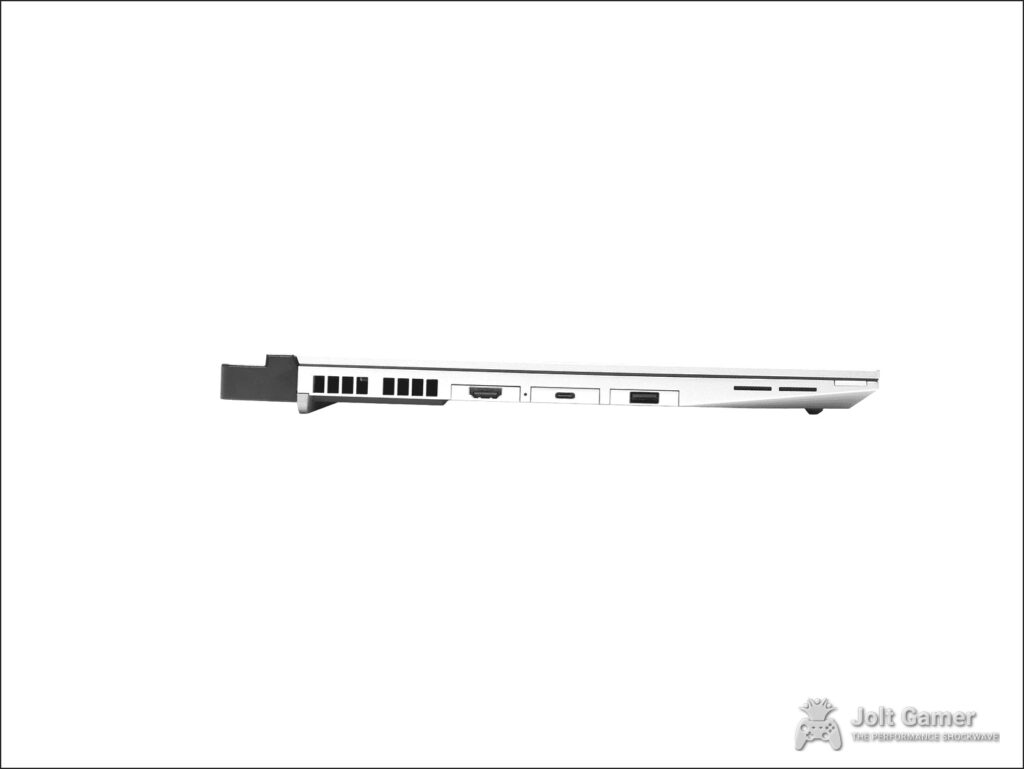
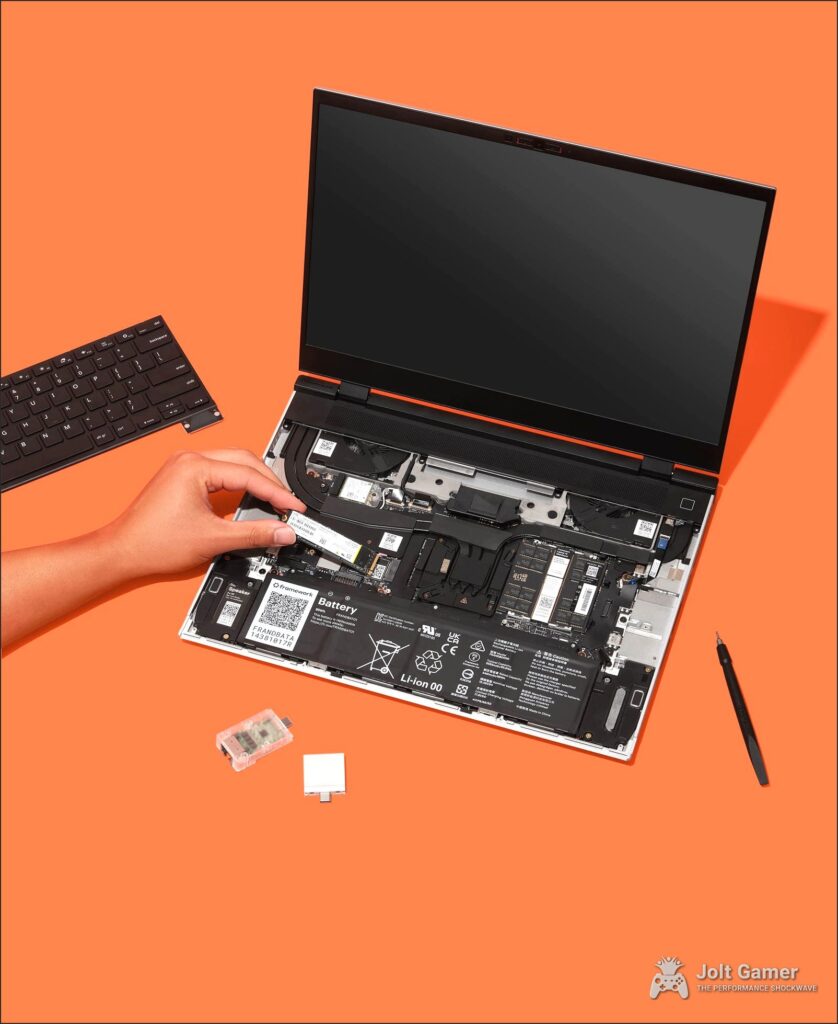
Living with the Framework Laptop 16 is an experience defined by personalization. Its input system is a testament to this, offering an unparalleled degree of customization. Users can tailor their setup with various keyboard layouts, add a numpad, integrate RGB macropads, or choose from different spacers, all controlled by open-source VIA software. This flexibility extends to the six hot-swappable Expansion Card slots, a practical marvel that allows users to instantly configure their ports for USB-C, USB-A, HDMI, DisplayPort, Ethernet, or even a microSD card reader. Daily use is further enhanced by an upgraded 1080p webcam, now featuring a 9.2-megapixel Omnivision sensor and physical privacy switches for both the camera and microphone—a thoughtful touch for security-conscious users. For many tech enthusiasts, the robust Linux support is a significant draw; distributions like Fedora 40 run exceptionally well out-of-the-box, demonstrating Framework’s commitment to a diverse user base.
- Robust Linux support out-of-the-box (e.g., Fedora 40 works well, Framework actively supporting more distros).
- High-quality 1080p webcam with physical privacy switches for enhanced security.
- New 240W USB-C PD 3.1 charger for powerful and flexible charging options.
- Reinforced CNC aluminum top cover for improved rigidity and durability.
- Open-source input modules and firmware (VIA, QMK) for unparalleled customization.
Build Quality & Overall User Experience
Pros
- Unmatched modularity and repairability (10/10 iFixit score) promoting longevity.
- Highly customizable input system and a versatile array of expansion ports.
- Excellent display quality with high refresh rate, VRR, and good color reproduction.
- Strong community engagement and Framework’s proactive responsiveness to feedback.
- Solid Linux compatibility, catering to a significant tech-savvy user base.
Cons
- Initial reports of flimsy build quality (top assembly, rattling spacers), though addressed by ‘Keyboard deflection kit’ and reinforced lid.
- Persistent keyboard inconsistencies (double presses, rattling) reported by some users even after RMA.
- Speakers consistently described as ‘surprisingly bad’ for a laptop of its size.
- Inconsistent battery life reports, with some users finding it disappointing for development tasks.
- Heavier and less portable than some competitors, especially with the dGPU module.
- Some reviewers noted a ‘first-gen product’ feel from a smaller company at launch.
The Modular Challenger: How Framework Stacks Up Against the Competition
In a market saturated with high-performance gaming laptops, the Framework Laptop 16 carves out a unique and compelling niche. Its value proposition isn’t solely about peak synthetic benchmarks or the thinnest chassis; it’s about longevity, user empowerment, and a sustainable lifecycle. Traditional gaming laptops, from brands like Razer, often prioritize raw, bleeding-edge performance in a sealed, non-serviceable package. While they might offer a slight edge in absolute power at any given moment, this comes at the cost of rapid obsolescence, forcing users into expensive full system replacements every few years. The Framework 16, by contrast, presents a different kind of value. It acknowledges an inherent trade-off: perhaps not always the *absolute* most powerful on day one compared to a top-tier competitor, but undeniably the most powerful in the long run, thanks to its unparalleled upgradeability. For gamers and creators who prioritize evolving their machine over time and minimizing e-waste, Framework offers a philosophy that extends far beyond a simple spec sheet.
Framework Laptop 16 (2025) vs. Key Competitors
| Feature | Framework Laptop 16 (2025) | Razer Blade 16 (2025) | Razer Blade 14 (2023) |
|---|---|---|---|
| Starting Price (DIY) | $1,499 (Ryzen 7, no dGPU) | $2,999+ | $2,400 |
| Max CPU | Ryzen AI 9 HX 370 | Intel Core i9-14900HX | AMD Ryzen 9 7940HS |
| Max GPU | Nvidia RTX 5070 | Nvidia RTX 4090 | Nvidia RTX 4070 |
| Max RAM | 96GB DDR5 | 96GB DDR5 | 16GB DDR5 |
| Max Storage | 10TB (2x M.2 + Bay) | 8TB (PCIe NVMe SSD) | 1TB (PCIe NVMe SSD) |
| Display | 16″ 2560×1600 165Hz G-Sync IPS | 16″ 2560×1600 240Hz OLED / Mini-LED | 14″ 2560×1600 240Hz IPS |
| Repairability Score | 10/10 (iFixit) | Low (Razer) | Low (Razer) |
| Wi-Fi | Wi-Fi 6E (9.6 Gbps) | Wi-Fi 7 (40 Gbps) | Wi-Fi 6E |
| USB Ports | 4x USB4 Type-C | 3x USB-A 3.2, 2x USB4 Type-C | 2x USB-A 3.2, 2x USB4 Type-C |
| Portability (Weight) | 4.6-5.29 lbs | 5.4 lbs | 4.0 lbs |
Investment in Longevity: Pricing, Pre-Orders, and Framework’s Horizon
Framework Laptop 16 (2025) Pricing & Availability
The 2025 Framework Laptop 16, with its significant upgrades, sees a modest price increase, starting at $1,499 for the DIY edition. While this represents a $100 bump from its original launch, the value proposition shifts dramatically when considering the cost of the new RTX 5070 module at $700 or a Ryzen 9 CPU upgrade for $300. Crucially, Framework is committed to accessibility; the original Laptop 16 model, featuring the Ryzen 7 7840HS, remains available at a reduced starting price of $1,299. This pricing strategy underscores Framework’s core philosophy: rather than buying a completely new laptop every two to three years, users are investing in a platform. The ability to incrementally upgrade key components—CPU, GPU, RAM, storage—transforms the initial purchase into a long-term investment, ultimately offering superior value and significantly extending the lifespan of your gaming machine compared to the disposable model of traditional manufacturers.
Regional Availability Note
Despite strong community desire, the Framework Laptop 16 (and other models) currently face limited regional availability, causing disappointment for many potential international buyers. Framework is actively working to expand its market reach.
Framework’s ambition extends far beyond laptops. The company’s broader mission is to fundamentally remake consumer electronics, championing open-source hardware and a future where every device is designed for longevity and user control. This commitment is evident in their open-sourcing of module systems, which has fostered a vibrant community developing everything from cyberdecks to commercial products. While laptops remain their primary focus, Framework has hinted at expanding into other categories, with modular smartphones being a tantalizing possibility. Furthermore, the growing interest in ARM-powered models for future Framework devices signals an exciting potential direction. Though current ARM SoCs don’t yet meet the performance requirements for their laptops, the industry is clearly moving towards higher-performance ARM processors for notebooks. This forward-looking perspective, combined with their recent expansion into the Laptop 12 and a modular desktop, illustrates that Framework is not just building products; it’s building an ecosystem, constantly looking to the horizon for the next frontier of user-empowered technology.
The Definitive Verdict: Framework 16, A Glimpse into Gaming’s Future?
The JoltGamer Final Verdict
The Framework Laptop 16, especially with its 2025 upgrades, represents a pivotal moment for gaming laptops. While early iterations had their flaws, Framework’s unwavering commitment to modularity and user feedback has forged a truly unique machine. It may not always win on raw, peak performance against every competitor, but its long-term value, unparalleled upgradeability, and ethical stance make it a compelling choice for gamers and creators who prioritize longevity, customization, and sustainability. The RTX 5070 and Ryzen AI CPUs elevate it from a niche curiosity to a serious contender, offering a powerful glimpse into a future where your gaming laptop evolves with you, rather than becoming e-waste.
Framework Laptop 16 (2025) Scorecard
Frequently Asked Questions About the Framework Laptop 16
What are the biggest new upgrades for the Framework Laptop 16 in 2025?
The main upgrades include the new Nvidia GeForce RTX 5070 laptop GPU module and the AMD Ryzen AI 300 series CPUs (Ryzen AI 7 350 / Ryzen AI 9 HX 370). It also gets a 240W USB-C charger and a reinforced top cover.
How much performance increase can I expect from the RTX 5070?
Framework projects a 30-40% increase in GPU performance over the original Radeon RX 7700S, significantly elevating its gaming capabilities.
Is the Framework Laptop 16 good for gaming?
With the new RTX 5070, it’s positioned for ‘PlayStation 5-class’ gaming performance. While the original RX 7700S was competitive, the RTX 5070 makes it a much stronger gaming contender, especially at its native 2560×1600 resolution.
What makes the Framework Laptop 16 so unique?
Its extreme modularity and repairability. Users can easily upgrade or replace the CPU, GPU, RAM, storage, battery, keyboard, touchpad, and expansion ports, promoting longevity and reducing e-waste.
Are there any downsides to the Framework Laptop 16?
Initial models faced concerns regarding build quality (flex, rattling), speaker quality, and inconsistent battery life. While Framework has addressed many issues, some users still report minor quirks. It’s also heavier than some competitors, especially with the dGPU, and regional availability is limited.
Can I upgrade my existing Framework Laptop 16 with the new components?
Yes, Framework is committed to backwards compatibility. The new RTX 5070 graphics module and Ryzen AI 300 series mainboards are designed to be compatible with existing Laptop 16 models.
How does its price compare to other gaming laptops?
The updated Framework Laptop 16 starts at $1,499, with configurations including the RTX 5070 reaching around $2,149. While competitively priced for its unique features, some traditional gaming laptops might offer slightly higher raw performance at similar price points, trading repairability for power.
Does it support Linux?
Yes, Framework laptops are known for strong Linux support. Fedora 40, for example, runs well out-of-the-box on the Framework Laptop 16, and Framework actively works on broader distribution support.
What is Framework’s long-term vision?
Framework aims to remake consumer electronics by building high-performance, long-lasting, and customizable products, potentially expanding into other categories like modular smartphones, and championing open-source hardware.


